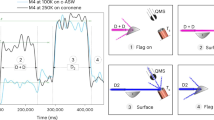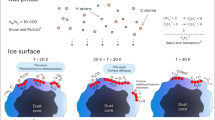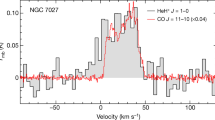Abstract
This paper reports results from an experiment designed to measure the nascent rovibrational population of H2 molecules that have formed through the heterogeneous recombination of H atoms on the surface of cosmic dust analogues under conditions approaching those of the interstellar medium (ISM). H2 that has formed on a highly oriented pyrolytic graphite (HOPG) surface has been detected, using laser induced resonance-enhanced multi-photon ionization (REMPI), in the v = 1 (J= 0–3) rovibrational states at surface temperatures of 30 K and 50 K. These excited product molecules display rotational temperatures significantly higher than the target surface temperature. These first results suggest that a considerable proportion of the binding energy released on formation of the H2 is deposited in the surface, in addition to internal excitation of the product molecules.
Similar content being viewed by others
References
Biham, O., Furman, I., Katz, N., Pirronello, V. and Vidali, G.: 1998, MNRAS 296, 869.
Farebrother, A.J., Meijer, A.J.H.M., Clary, D.C. and Fisher, A.J.: 2000, Chem. Phys. Lett. 319, 303
Ghio, E., Mattera, C., Salvo, C., Tommasini, F. and Valbusa, U.: 1980, J. Chem. Phys. 73, 556.
Gough, S., Schermann, C., Pichou, F., Landau, M., Cadez, I. and Hall, R.I.: 1996, Astron. Astrophys. 305, 687.
Gould, R.J. and Salpeter, E.E.: 1963, Astrophys. J. 138, 393.
Hollenbach, D. and Salpeter, E.E.: 1970, J. Chem. Phys. 53, 79.
Hollenbach, D. and Salpeter, E.E.: 1971, Astrophys. J. 163, 155.
Hollenbach, D., Werner, M.W. and Salpeter, E.E.: 1971, Astrophys. J. 163, 165.
Jeloaica, L. and Sidis, V.: 1999, Chem. Phys. Lett. 300, 157.
Katz, N., Furman, I., Biham, O., Pirronello, V. and Vidali, G.: 1999, Astrophys. J. 522, 305.
Manico, G., Raguni, G., Pirronello, V., Roser, J.E. and Vidali, G.: 2001, Astrophys. J. 548, L253.
Mathis, J.S.: 1990, Annu. Rev. Astron. Astrophys. 28, 37.
Meijer, A.J.H.M., Farebrother, A.J., Clary, D.C. and Fisher, A.J.: 2001, J. Phys. Chem. A 105, 2173.
Papoular, R., Conard, J., Guillois, O., Nenner, I., Reynaud, C. and Rouzaud, J.N.: 1996, Astron. Astrophys. 315, 222.
Perry, J.S.A., Gingell, J.M., Newson, K.A., To, J., Watanabe, N. and Price, S.D.: 2002, Meas. Sci. Technol. 13, 1414.
Pirronello, V., Liu, C., Shen, L.Y. and Vidali, G.: 1997a, Astrophys. J. 475, L69.
Pirronello, V., Biham, O., Liu, C., Shen, L.O. and Vidali, G.: 1997b, Astrophys. J. 483, L131.
Pirronello, V., Liu, C., Roser, J.E. and Vidali, G.: 1999, Astron. Astrophys. 344, 681.
Rutigliano, M., Cacciatore, M. and Billing, G.D.: 2001, Chem. Phys. Lett. 340, 13.
Sandford, S.A., Allamandola, L.J. and Geballe, T.R.: 1993, Science 262, 400.
Sha, X.W. and Jackson, B.: 2002, Surf. Sci. 496, 318.
Takahashi, J., Masuda, K. and Nagaoka, M.: 1999a, MNRAS 306, 22.
Takahashi, J., Masuda, K. and Nagaoka, M.: 1999b, Astrophys. J. 520, 724.
Walraven, J.T.M. and Silvera, I.F.: 1982, Rev. Sci. Instrum. 53, 1167.
Williams, D.A.: 1968, Astrophys. J. 151, 935.
Williams, D.A. and Hartquist, T.W.: 1999, Accounts Chem. Res. 32, 334.
Author information
Authors and Affiliations
Rights and permissions
About this article
Cite this article
Perry, J., Price, S. Detection of rovibrationally excited H2 formed through the heterogeneous recombination of H atoms on a cold HOPG surface. Astrophysics and Space Science 285, 769–776 (2003). https://doi.org/10.1023/A:1026181815008
Issue Date:
DOI: https://doi.org/10.1023/A:1026181815008




